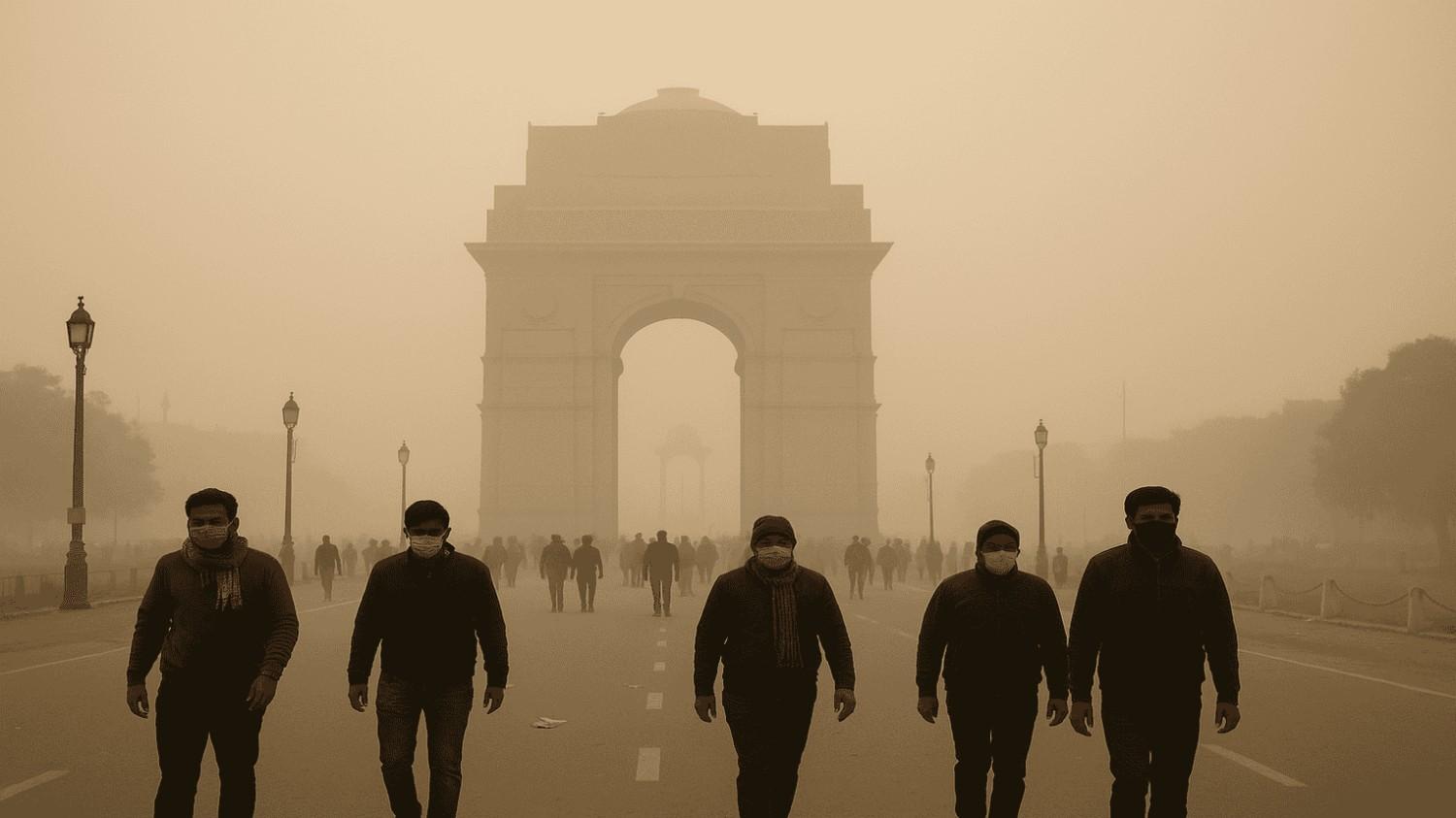
Table of Contents
ToggleA City Gasping for Breath
Every year when the air cools, Delhi disappears under a grey blanket. Buildings fade, throats burn, and people rush to pharmacies in search of relief. It has almost become a seasonal ritual — except this year, the situation looks even worse.
In the first week of November, air-quality monitors recorded AQI levels above 450, a range classified as “severe.” For many residents, that means burning eyes, blocked noses, and breath that feels heavier with every inhale. Doctors say these readings are dangerous not just for patients with asthma or heart disease — they are unhealthy for everyone.
What’s Behind the Smog?
The reasons are complex but predictable. Each winter, smoke from crop-residue burning in Punjab and Haryana drifts toward Delhi. That combines with vehicular exhaust, factory smoke, and construction dust already hanging in the city’s still air.
Because colder air traps pollutants close to the ground, the toxins linger for days. Add festive fireworks and the result is a suffocating haze that refuses to lift.
Health Impacts Doctors Are Seeing
Hospitals across Delhi are reporting a sharp increase in respiratory complaints. Outpatient departments are full of people struggling with persistent coughs, headaches, and chest tightness.
Doctors say short-term exposure can cause sore throats, eye irritation, and fatigue. But the long-term impact is far more serious. Studies published in The Lancet and other journals link continuous exposure to:
- Chronic lung conditions like COPD and asthma
- Higher chances of heart attack and stroke
- Poor pregnancy outcomes and low birth weight
- Decline in cognitive function over time
“The damage is invisible at first,” explains a Delhi-based pulmonologist, “but after years of breathing this air, the lungs of a non-smoker can look like those of a heavy smoker.”
Children and the Elderly Hit the Hardest
Children breathe faster and take in more air per kilogram of body weight, which means they absorb more pollutants. Pediatricians report rising cases of wheezing and asthma even among children with no family history of lung disease.
The elderly are equally vulnerable. For people with existing heart or lung problems, even a few days of poor air can trigger emergencies. A study by the Energy Policy Institute at the University of Chicago suggests that Delhi residents could lose up to 12 years of life expectancy if current pollution levels persist.
Government Measures and Their Limits
Authorities have once again activated the Graded Response Action Plan (GRAP) — closing construction sites, banning diesel generators, and advising schools to reduce outdoor activity. If conditions worsen, odd-even vehicle restrictions may follow.
These steps help temporarily, but experts argue they treat the symptoms, not the cause. Without long-term reforms in transportation, agriculture, and industrial control, Delhi’s annual smog may keep returning like clockwork.
How Citizens Can Protect Themselves
While broader policies evolve, small personal actions can cut exposure:
- Check AQI daily on reliable apps like SAFAR or CPCB.
- Wear N95 or KN95 masks outdoors; cloth masks don’t filter fine particles.
- Use air purifiers with HEPA filters at home and workplaces.
- Keep windows closed during peak pollution hours, usually early morning and late night.
- Avoid outdoor exercise when AQI crosses 200.
- Eat foods rich in antioxidants — fruits, leafy vegetables, and omega-3 sources.
Even short indoor breaks during heavy smog can reduce daily exposure significantly.
The “Silent Epidemic” Experts Warn About
Public-health specialists call Delhi’s situation a slow-moving epidemic. Unlike COVID-19, it doesn’t fill hospitals overnight, but it steadily erodes public health. Over the years, the city has seen rising cases of respiratory disease, cardiovascular disorders, and even mental-health complaints linked to air quality.
Dr Arvind Kumar, one of Delhi’s leading chest surgeons, summed it up bluntly:
“We are breathing poison every single day. The crisis is not seasonal anymore — it’s permanent.”
Long-Term Fixes: What Needs to Change
Experts agree that the city needs coordinated action across multiple sectors:
- Support for farmers to manage stubble without burning it.
- Expansion of electric public transport and strict emission checks for vehicles.
- Tougher industrial pollution standards and better monitoring.
- Large-scale urban tree planting and dust-control programs.
These steps require persistence, political will, and public participation — but without them, the next generation will inherit an unbreathable city.
Conclusion
Delhi’s air crisis has moved far beyond inconvenience. It is now a public-health emergency touching nearly every household. While individuals can take precautions, real change depends on systemic reform and collective responsibility.
Until that happens, the simple act of breathing in Delhi will remain a daily health risk — a reminder that clean air is not a luxury, but a basic right.
Sources
- Central Pollution Control Board (CPCB) daily AQI reports
- Energy Policy Institute at the University of Chicago (EPIC), 2023
- The Lancet – Global Burden of Disease Study on Air Pollution
- Ministry of Earth Sciences – System of Air Quality and Weather Forecasting (SAFAR)
- Interviews with Delhi-based pulmonologists, 2024–2025



